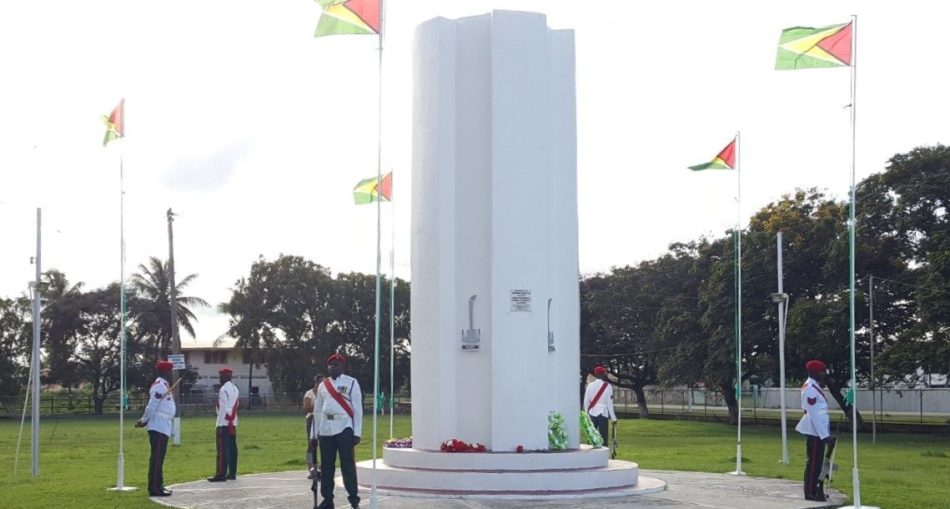The Enmore Martyrs’ Monument is a memorial structure, designed by Stanley Greaves which is located at Enmore village on the East Coast of Demerara. The Enmore Martyrs’ Monument was unveiled on June 16th, 1977 in Enmore Village, almost thirty (30) years after the disaster in which the five sugar workers were killed. While the monument is one of Guyana’s most famous, there is a dark history behind it. During a protest against unjust working conditions and poor wages, five (5) sugar workers were shot down by the British Colonial Police. This monument was constructed in honour of these five (5) sugar workers-Rambaran, Harry, Lallabagee, Lall and Suruj-bally. They, along with hundreds more were protesting the new system of harvesting which was more tedious work than the prior system. They were forced to take strike action when the British Guiana Authorities refused to change the new system and their union – the Man Power Citizen’s Association (MPCA), sided with the Sugar Producers Association (SPA) on many occasions against them. So, a new union was formed – Guyana Industrial Workers Union (GIWU) to do negotiations on their behalf however, the SPA would only deal with the MPCA. The Guyana Industrial Workers Union (GIWU) then called for strike action.

Enmore Martyrs’ Monument – Image Source: Demerarawaves
Features of the Enmore Martyrs’ Monument
The Enmore Martyrs’ Monument is a seven (7) metre high structure made with unpainted white cement. There are five (5) flutes and five brass symbols engraved into the monument with the likeliness of cutlasses. Each of the five (5) brass pieces bears the name of the five sugar workers who were killed – Rambaran, Harry, Lallabagee, Lall and Suruj-bally.
History of the Enmore Martyrs’ Monument
On the morning of 16th June 1948, a crowd of approximately four hundred (400) sugar workers had assembled outside the factory at Enmore for a demonstration and picketing exercise against the unfair wages and working conditions. These protests had been going on for a length of time as the Sugar Producers Association (SPA) refused to meet the demand for the change of the harvesting system and the workers continued to suffer. The sugar workers were also angered by the fact that the estate had employed outside labour to complete their work instead of negotiating with their own workers. They found the factory protected by a number of policemen, armed with live ammunition, inside the factory compound surrounded by its fifteen (15) feet fence with rows of barbed wires. Management of the estate had anticipated this protest and had thus requested assistance from the police.
As the morning grew on, the crowd began to grow in size. Four hundred (400) persons increased to somewhere between five hundred (500) and six hundred (600). Becoming increasingly frustrated with their situation, led by one of the workers carrying a red flag, they attempted to enter the compound through the gates and also through the entrance by which the punts used to carry the sugar cane would enter. The presence of the policemen prevented them from doing so, however, a few of them were able to enter. The workers then proceeded to hurl sticks and stones at the policemen.
After failing to keep the crowd back, the policemen then opened fire upon the crowd. Fourteen (14) workers were injured and five were killed. The five (5) were Rambaran, Harry, Lallabagee, Lall and Suruj-bally. They would later come to be known as the Enmore Martyrs. Rambarran died from bullet wounds in his leg, Lallabagee Kissoon was shot in the back and Harry died a day later due to severe spinal injuries. There is little to no information about the deaths of Lall and Surujbally. A funeral was held for the workers on June 17th and many were in attendance. The procession was led by Dr. Cheddi Jagan and The Guyana Industrial Workers Union (GIWU). The tragedy and sacrifice of the sugar workers opened eyes to the plight of the workers. A commission of enquiry into the incident was ordered. The report prepared justified the shooting. However, evidence suggested that after the workers retreated, the police continued firing which led to injuries and the death of the workers.
About The Enmore Martyr’s Monument
This martyrdom of the Enmore workers along with others served to propel the leaders to fight harder for freedom of the people of Guyana from colonial bondage. It also enabled better working conditions and wages for workers. The GIWU union eventually became known as Guyana Agricultural Workers Union (GAWU) and they continue to find for workers’ rights, especially sugar workers. The martyrdom of the five Enmore sugar workers was recognized at the Continental Conference of the national affiliates of the World Peace Council, which met in Bogota, Columbia during June 4-7, 1976. The Enmore Martyrs’ Monument is a dedication to these five (5) brave persons who gave their lives for workers’ rights in Guyana.
Article References
- https://www.guyanatimesinternational.com/the-enmore-martyrs-monument/
- http://www.guyana.org/features/guyanastory/chapter119.html
- http://www.guyanajournal.com/Enmore_Martyrs_melcarpen.html
- https://dpi.gov.gy/remembering-the-enmore-martyrs-on-72nd-
- anniversary/#:~:text=The%20five%20were%20Rambarran%2C%20Pooran,was%20introduced%20to%20in%201945
Discover more from Things Guyana
Subscribe to get the latest posts sent to your email.







